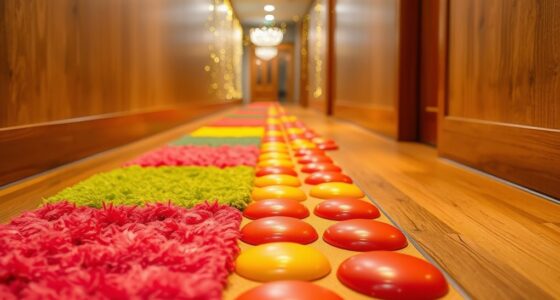You can make fun, safe, and budget-friendly kinetic sand alternatives using household items. For example, spoil your kids with homemade moon sand, mixing flour and cornstarch with a bit of water. Or try edible sensory dough made with sugar, cornstarch, and lotion for safe fun. Gel-like materials using gelatin or agar create squishy, wobbly textures. If you’re curious about more creative options, keep exploring—they’ll inspire your next DIY sensory project.
Key Takeaways
- Homemade moon sand using flour, cornstarch, and water offers a moldable, kinetic-like texture similar to commercial kinetic sand.
- Edible sensory play dough made from powdered sugar, cornstarch, and lotion provides a soft, squishy alternative safe for young children.
- Gel-like materials using gelatin or agar create a cool, squishy, and wobbling sensory experience, mimicking kinetic sand’s tactile feel.
- DIY sensory materials can be customized in texture, color, and safety, serving as cost-effective substitutes for commercial kinetic sand.
- Crafting these alternatives encourages creativity, safe play, and sensory exploration with household ingredients.

If you love the sensory experience of kinetic sand but want to explore other options, there are plenty of alternatives that offer similar fun and tactile engagement. You can create your own sensory play materials right at home through simple DIY projects. These homemade craft projects not only save money but also give you the chance to customize textures, colors, and consistencies to suit your preferences and those of your kids. Plus, making your own sensory materials can be a rewarding activity that sparks creativity and allows you to experiment with different ingredients.
One popular option is homemade moon sand, which mimics the soft, moldable qualities of kinetic sand. To make it, you typically combine flour and cornstarch in a ratio of about 2:1, then slowly add water until you reach the desired consistency. Some recipes call for a little bit of oil or dish soap to enhance the texture and make it more pliable. This DIY sensory play material can be molded, shaped, and squished just like kinetic sand, offering hours of tactile fun. It’s especially great because it’s easy to clean up—just scoop or pour it back into a container when playtime’s over. Additionally, because moon sand is made from common household ingredients, it can be a safer and more natural alternative to commercial kinetic sand.
Homemade moon sand is easy to make and fun to mold, offering a soft, tactile play experience.
Another engaging homemade craft project involves creating edible sensory play dough. Using simple ingredients like powdered sugar, cornstarch, and a small amount of lotion or vegetable oil, you can make a soft, pliable dough that’s safe for younger children. This type of homemade craft project combines sensory exploration with the bonus of being edible, providing an added layer of safety and fun. It’s perfect for children who love to squish, roll, and mold, and it can be colored with food dye for added visual appeal.
If you want something with a more gel-like consistency, you can make a jelly-like slime or gel cubes using clear gelatin or agar agar. These materials offer a different sensory experience—cool, squishy, and slightly wobbly—that’s ideal for tactile stimulation. You can embed small toys or objects inside for extra curiosity and engagement.
In all cases, DIY sensory play allows you to control the ingredients, making it safer and more personalized. Experimenting with homemade craft projects like moon sand, edible dough, or gel-based materials offers a fun, creative way to mimic kinetic sand’s tactile satisfaction. Whether for a sensory bin, calming activity, or just plain fun, these homemade alternatives are simple, effective, and customizable options that bring the joy of sensory play into your home. Moreover, understanding sensory materials can help you choose the best options suited to your child’s needs and safety considerations.
Frequently Asked Questions
Are Homemade Kinetic Sand Alternatives Safe for Children?
Yes, homemade kinetic sand alternatives are generally safe for children when you use non-toxic ingredients. They’re perfect for sensory play, helping your child explore textures securely. Always choose food-grade or non-toxic materials, and supervise playtime to prevent ingestion or misuse. Making your own guarantees you control the ingredients, reducing risks associated with commercial products. With proper precautions, your child can enjoy sensory play safely and creatively at home.
How Long Do DIY Kinetic Sand Substitutes Last?
Did you know homemade kinetic sand substitutes typically last around 2 to 4 weeks? The shelf life depends on factors like storage conditions and ingredients. When stored in an airtight container, your DIY mix maintains its texture consistency longer, but it may dry out or become moldy over time. To extend its lifespan, keep it in a cool, dry place and add a bit of water or oil if it starts to lose its softness.
Can I Use Natural Ingredients for Homemade Kinetic Sand?
Yes, you can use natural ingredients for homemade kinetic sand to enhance your sensory play. For example, combine natural flour or cornstarch with water and a bit of natural oil, like coconut or olive oil. These ingredients create a soft, moldable texture perfect for sensory exploration. Using natural ingredients makes your sensory play safer and more eco-friendly, allowing you to enjoy creative, hands-on fun without synthetic additives.
What Are the Best Storage Methods for Homemade Sand?
To keep your homemade sand fresh and prevent it from drying out, store it in an airtight container. This guarantees proper sand preservation and keeps it moist and pliable for future play. Use clear containers for easy container organization, so you can quickly find and access your sand. Label each container, and store it in a cool, dry place away from direct sunlight. This method maintains the quality of your homemade sand for longer fun sessions.
Are There Any Environmental Benefits to Making Your Own?
Yes, making your own kinetic sand alternatives offers several environmental benefits. By using eco-friendly materials like natural sand, cornstarch, or recycled items, you reduce waste and minimize the need for synthetic products. This promotes recycling benefits and encourages sustainable practices. Plus, DIY projects often have a smaller carbon footprint, helping you contribute to a healthier planet while enjoying a fun, eco-conscious activity.
Conclusion
Creating your own kinetic sand alternatives at home is easy and fun. Not only do you save money, but you also get to customize textures and colors to suit your preferences. Did you know that homemade sensory toys can boost fine motor skills and creativity in children? With just a few simple ingredients, you can craft a satisfying, mess-free play experience that engages your senses and sparks imagination—all from the comfort of your own home.










